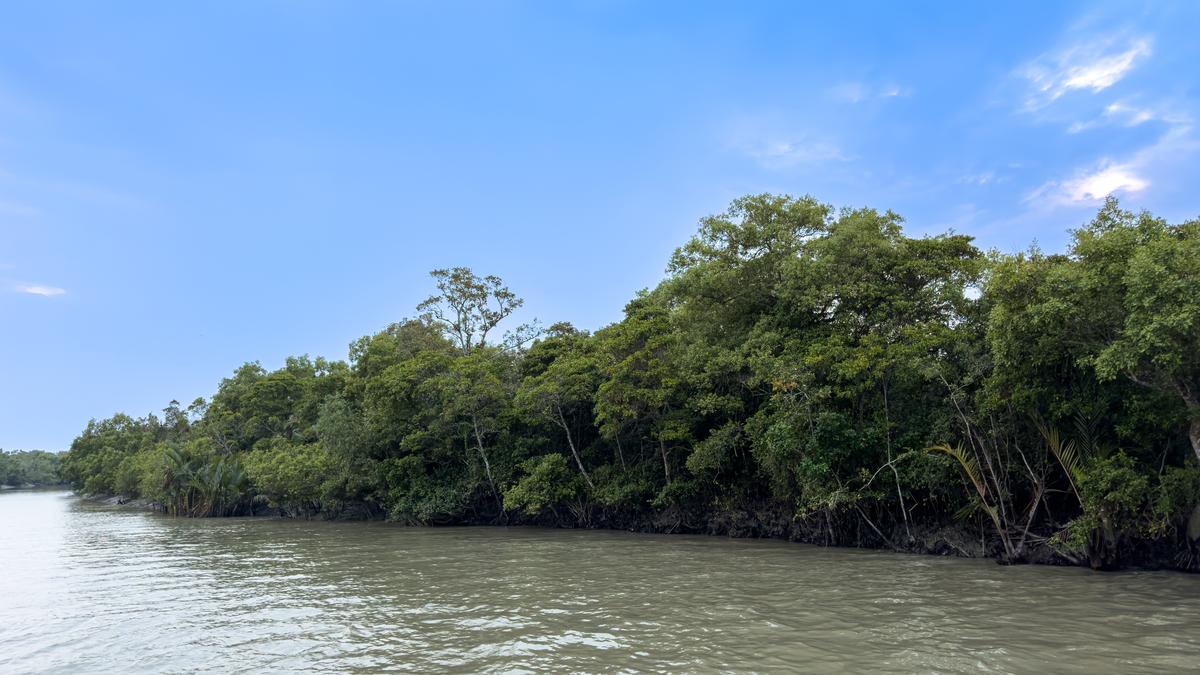
‘As the world grapples with extreme weather events, blue carbon ecosystems such as mangroves are critical to climate and economic resilience’
| Photo Credit: Getty Images
Mangroves have, historically, been on the margins of planning and policy priorities in spite of their vital role in anchoring coastal economies and protecting millions from climate extremes. Their loss is not just an environmental concern. Their loss erodes natural infrastructure that acts as a buffer for urban coastlines, underpins fisheries, and quietly contributes billions in ecosystem services and avoided damages.
As the world grapples with extreme weather events and rising sea levels, blue carbon ecosystems such as mangroves are critical to climate and economic resilience. Yet, their value rarely features in balance sheets or policy frameworks. How can businesses, governments, and communities reimagine these ecosystems as active drivers of sustainable growth and security? Three pillars of our work through the Mangrove Coalition offer ideas for the path forward.
Mapping with technology
First, embracing technology can help us better understand the value of “Natural Capital”. Satellite and drone data with advanced geospatial Artificial Intelligence algorithms have improved accurate mangrove mapping and blue carbon quantification. This is crucial for informing policies and restoration efforts. The economic and ecosystem services valuation of mangroves ranges from ₹3,535 million in Pichavaram (Tamil Nadu) to ₹664 billion in the Sundarbans (West Bengal). Carbon sequestration alone is valued at ₹462 million per year in the Sundarbans, reflecting the ecological and economic importance of this habitat. Communities that possess deep knowledge of mangrove ecosystems and rely on them for their livelihoods, must be prioritised and equitably benefited — socially and economically.
Involving communities
Second, community-led conservation efforts are key to strengthening symbiotic and mutually respectful relationships of people and nature. Fisherfolk especially value the role of mangroves as nurseries for juvenile fish. Healthy mangroves often translate into robust fish stocks, ensuring sustainable catch. The livelihoods of these coastal communities are intrinsically linked to the quality of mangrove and estuarine systems.
In dense urban settings such as Mumbai and Chennai, mangroves are often distressed, polluted and degraded. Since they are unable to support flourishing biodiversity, coastal livelihoods and socio-cultural interdependencies are compromised. However, when communities directly experience the benefits (more fish, cleaner air, protected homes) and are empowered to make decisions about their local environment, they become effective and enduring stewards. Mangroves and other coastal ecosystems can also create opportunities for alternative livelihoods such as aquaculture, beekeeping and eco-tourism. Integrated ownership models such as Eco-Development Committees (EDCs) or Joint Forest Management Committees (JFMCs) can be translated for urban mangroves.
Third, citizen science can engage stakeholders to generate wonder and investment in this undervalued ecosystem and mobilise collective action for conservation. When community members from varied backgrounds are skilled to understand and monitor ecosystems, this can either supplement existing assessment efforts or substitute for formal monitoring. Mangrove health is intertwined with the vitality of associated ecosystems and wetlands, and the health of rivers from source to the sea, as they contribute freshwater, sediments and biota. Regular monitoring can provide a good indication of how the system is faring.
Platforms can play a pivotal role
Key components of a mangrove health tool should include indicators around changes in mangrove area; quantity, quality and timing of freshwater flows; avian, floral, molluscan and fish diversity; and, crucially, community dependence and a perception of the ecosystem services. Such assessments can provide key insights to support management actions. Engagement platforms such as “Mangrove Mitras” or Friends of Mangroves can open avenues for urban citizens and local communities to engage constructively in the conservation of mangroves. This could help to rebuild a people-wetland-river-mangrove connection through an immersive experience on the magical value of mangroves.
Sustainable stewardship is not a top-down mandate but a symbiotic relationship where mangrove health and people’s well-being are mutually reinforcing. Policymakers and businesses must recognise mangroves as vital climate and economic infrastructure rather than mere biodiversity zones. Protecting and restoring these ecosystems demands a coalition where science, business and community voices work in harmony — each bringing unique strengths to secure their future.
Madhav Pai is the CEO of WRI India. Soumya Swaminathan is the Chair of the M.S. Swaminathan Research Foundation. Sejal Worah is the Programme Director of WWF India
Published – August 02, 2025 12:08 am IST
